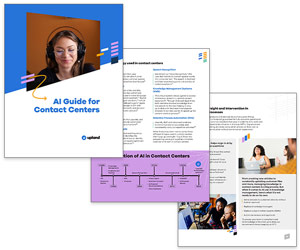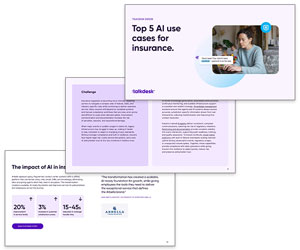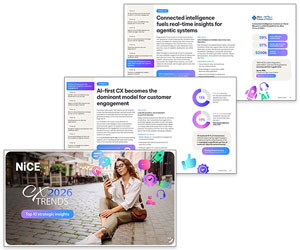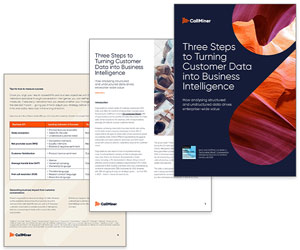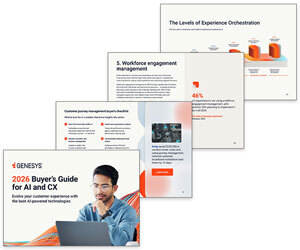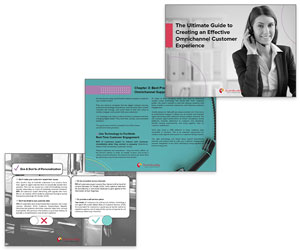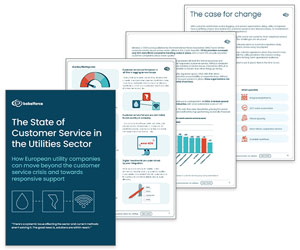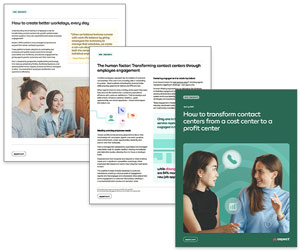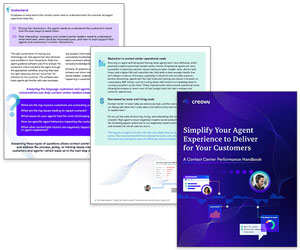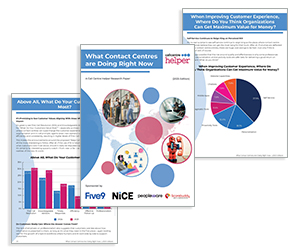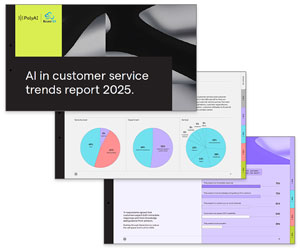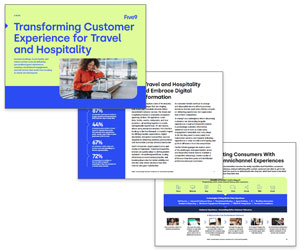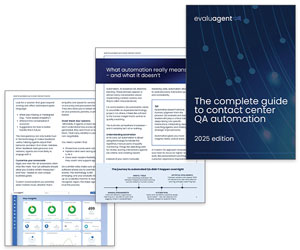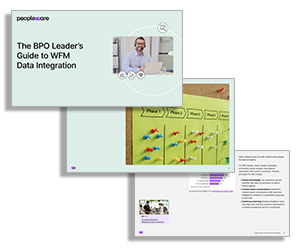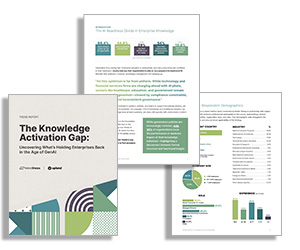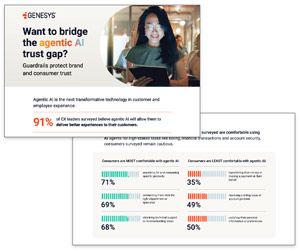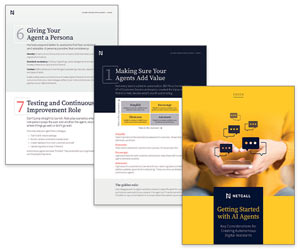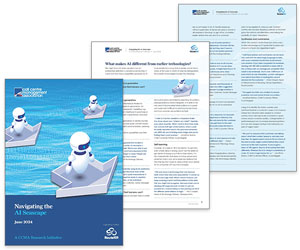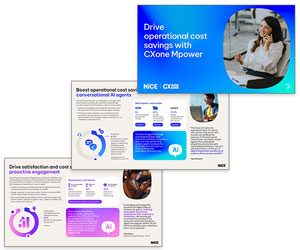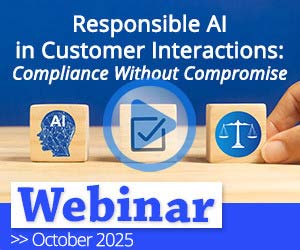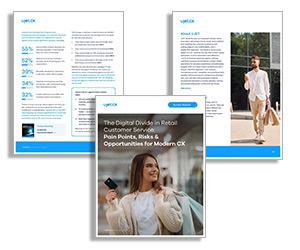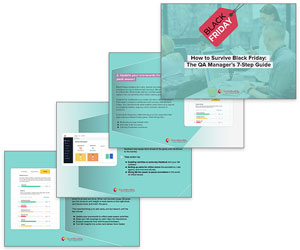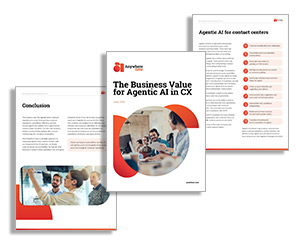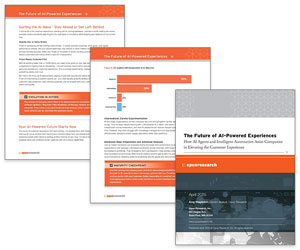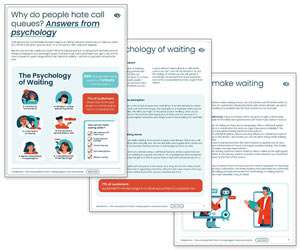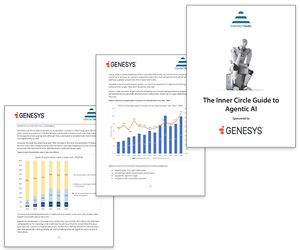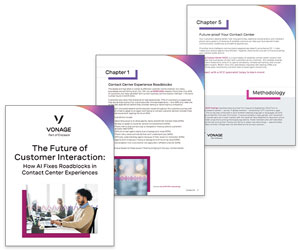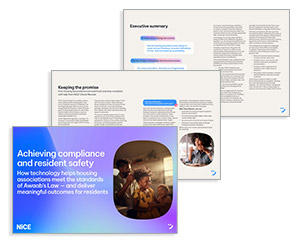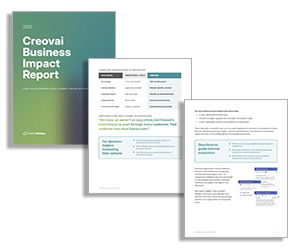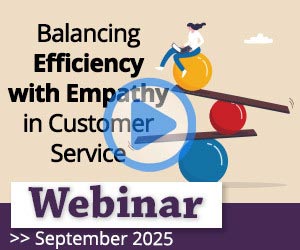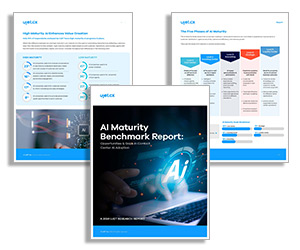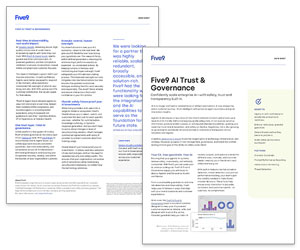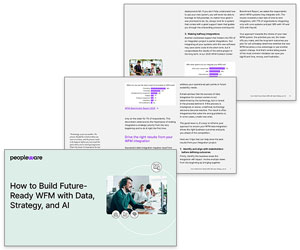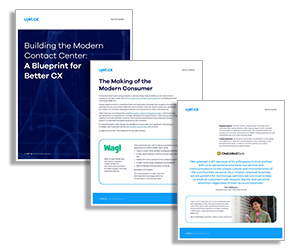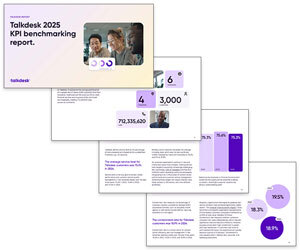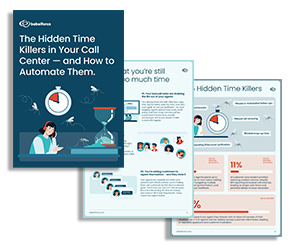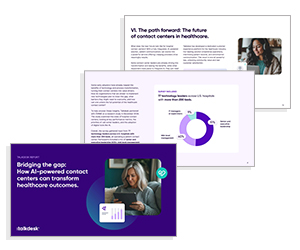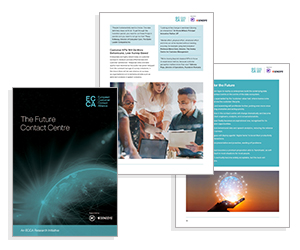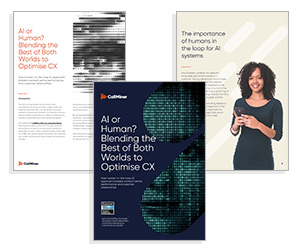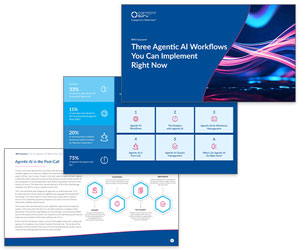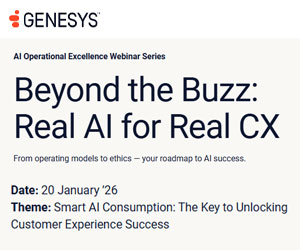Reports, White Papers and Latest Resources
Reports and White papers represent a great way to read in depth about some of the issues facing call centres.
Organisations are rapidly transforming CX through the adoption of AI, with tangible benefits for both teams and customers. But what does this transformation look like in practice?
For the optimal personalized customer experience, contact center technology needs to constantly evolve. That means investing more in contact center AI. Trying to run and manage contact centers today without some level of AI will ultimately fall short of customer’s 24/7 service expectations. To navigate the different contact center AI technology, this comprehensive guide is for you.
Most contact centres still manage quality reactively—sampling just 3% of interactions and missing what truly drives CX success. This eBook explores how Agentic Quality Management (AQM) replaces blind spots with breakthroughs by using AI to evaluate every interaction in real time. You’ll learn how visibility fuels fairness, empowers agents, and builds trust—creating a self-optimising contact centre that learns, adapts, and continuously improves with every interaction.
NiCE has been named a leader in the IDC MarketScape for European Contact Center-as-a-Service (CCaaS) Applications Software Vendor Assessment 2025.
Few other public sector organisations handle so many critical interactions, or have to respond with such speed and precision. Even fewer of those organisations are in such high-stakes contact with the general public. Police forces move fast, handle vast and unpredictable challenges, and must preserve the trust of communities. In the age of AI, how can police forces rise to the challenge?
Are you searching for an effective and straightforward method to enhance the performance of your contact center? Look no further! This free, downloadable call center quality assurance scorecard template is designed to provide you with a comprehensive framework for assessing agent interactions and identifying key areas for improvement.
We’re at the end of 2025 and have seen huge leaps forward in digital-first, AI-enabled tools. So, what’s in store for 2026? And how will these innovations and trends continue to reshape the art of the possible in CX? Watch this webinar where our expert panel take an in-depth look at what the future of contact centres is set to look like next year, so you can refine your plans and stay truly competitive into 2026 and beyond.
Policyholders today expect speed, clarity, and personalized support at every touchpoint. Delivering exceptional experiences requires balancing automation with human empathy. This ebook explores the top AI use cases in insurance, showing how technology empowers insurers.
Discover the future of Customer Experience with NiCEs eBook “CX 2026 Trends: Top Strategic Insights” Learn which trends will shape experiences, where to invest for lasting impact, and how to balance AI with human expertise. For leaders aiming to turn CX into an advantage, this report is your roadmap.
Every year MaxContact analyse how UK contact centres are performing and where leaders are gaining an edge.
According to CallMiner’s annual CX Landscape Report, 68% of organisations aim to use the CX data they collect to make data-driven decisions. This data is invaluable for contact centre and CX teams, and is being applied to some of the world’s leading organisations across every department. This guide will give you tips and show you examples of how to do it too.
Customer expectations have never been higher. Your brand isn’t just measured against your competitors; it’s compared to the best experiences your customers have anywhere.
Zendesk’s latest CX Trends Report shows how AI is reshaping customer experience. With insights from more than 11,000 consumers and CX leaders across 22 countries, the report highlights how contextual intelligence is becoming the new standard for smarter, faster, and more personalised support.
What channels does your brand use to connect with customers? Is it through Phone, Chat, or Email? In todays fast-paced digital world, consumers are more connected than ever before. According to a recent study by Marketing Week, the average technology-savvy consumer utilizes an impressive six touch-points to engage with brands. This highlights the importance of being present and responsive across multiple platforms. In this guide, Scorebuddy delve into everything you need to know about crafting a seamless and effective omnichannel customer experience.
IDC has published its first-ever IDC MarketScape for European Contact Center as a Service (CCaaS) , offering independent insight into how providers support customer experience transformation and Five9 has been named as a Leader.
Is There a Customer Service Crisis in Utilities? The headlines say yes, but is the situation as dire as it seems? If you want to be the best utility for customer care, download this white paper which explores the unique challenges faced by utilities support teams, and the automation strategies some companies are using to slash wait times and operational costs.
Contact centers have the potential to become strategic growth engines that drive profitability, enhance customer loyalty, and create sustainable competitive advantage. However, this strategic shift requires a fundamental change in how businesses approach their operations—particularly in how they invest in their most valuable asset: people. This white paper explains how engaged agents can turn routine interactions into meaningful customer conversations, improving both customer experience and business results.
Contact center leaders looking to improve the customer experience need to consider how to bring AI into their operations without damaging the customer experience. According to Microsofts Global State of Customer Service, 86% of customers expect to be able to help themselves with a self-service option. And two-thirds will try self-service before contacting a live agent.
CX is often seen by analysts as a key area for Generative AI initiative deployments, with a 2023 Gartner poll finding that 38% of executives cited CX and retention as their primary focus for the technology.
AI Is Reshaping Customer Experience - Are You Ready? This Gartner Research outlines the four essential pillars for successful AI implementation in customer service, with a research-backed framework to help customer service leaders implement AI with confidence.
The demand to speak to a human customer service agent isn’t going away. And if you’re not equipping your agents with the tools and training they need to succeed, there’s a high likelihood they’ll burn out and leave—negatively impacting the customer experience in the process.
The results are in! We’ve just wrapped our annual “What Contact Centres Are Doing Right Now” research and the story this year is clear: AI is continuing to evolve from hype to day-to-day reality, while leaders juggle tighter budgets, shifting channels, and the return to more face-to-face teamwork.
Every customer interaction has the potential to be either a risk or a chance to strengthen your brand. In today’s data-rich but insight-poor environment, traditional performance metrics just aren’t enough. How can CX and contact centre leaders shift the basic measures of performance in a way that can help provide deeper insights?
This PolyAI report takes a closer look at how generative AI is transforming customer service in large enterprises. Based on a survey of 100 customer experience (CX) leaders from major US and UK companies (each with over $500 million in annual revenue), it offers clear, practical insights for anyone looking to navigate the fast-changing world of AI in CX.
Unlock the power of agentic AI to transform customer experience. This in-depth report, produced in partnership with ContactBabel, reveals how AI-driven automation is reshaping contact centres – boosting self-service, streamlining operations and enhancing customer experience. It’s your essential resource for understanding the future of AI customer service.
Increase bookings, boost loyalty, and reduce service costs by delivering personalised guest experiences, seamless omnichannel engagement, and self-service that works from booking to check-out and beyond. In this eBook Five9 explore some of the industry trends and challenges that are shaping how Travel and Hospitality brands deliver exceptional customer service.
What does it take to get a customer from being interested in your brand to investing in your product or services? Well, it’s a journey of a dozen little steps.
Agentic AI is entering ‘buzzword’ territory (or maybe it already has!) but once you match it with a real-world use case, it becomes a lot more concrete. While our old chatbots needed rigid, step-by-step directions, all agentic AI needs is a compass and a destination—it will find the way on its own. This opens up fresh opportunities for self-service, workflow optimization, data analysis, and more, but it brings added risk too—and this is where QA comes in. If interaction volumes are scaling with AI, your QA function must keep up. So read this guide to find out what you can do.
Still only reviewing a fraction of your customer interactions? It’s time to move to smarter, scalable QA by downloading this in-depth guide covering the true costs of manual QA, key automation technologies, and how to measure ROI and future-proof your QA strategy.
Yes, the rules have changed – yet again – on what it takes to design an exceptional customer experience. Driven by ever higher customer expectations and even tighter budgets, contact centre leaders are being forced to do more with less. But how are they doing this without sacrificing quality and the human touch? Watch this webinar where our panel of experts share real-life examples of how organizations are succeeding in building truly meaningful connections with their customers and pulling out all the stops to amplify the human experience in an AI-driven world.
Managing multiple clients across disconnected data sources and outdated legacy systems makes it challenging for BPOs to forecast accurately, optimize resources, and consistently deliver the seamless experiences that clients and their customers expect.
Spoiler: AI isn’t the magic wand everyone hoped it would be. New research from Upland + Metric Sherpa dives into why customer support teams are struggling with knowledge management and how to actually fix it.
AnywhereNow, in partnership with ContactBabel, presents The Inner Circle Guide to Agentic AI - your essential resource for understanding the next evolution in contact center automation.
Agentic AI is the future of customer interactions, yet trust remains fragile. Discover why building guardrails isn’t just smart; it’s essential. These insights are drawn from a global survey involving 4,000 consumers and 1,600 customer experience (CX) and IT leaders, revealing trends and insights shaping the future of agentic AI.
Autonomous agents are changing the game. They’re not just answering questions – they’re solving problems, connecting systems and working alongside your teams. But getting started can feel daunting.
This exclusive CCMA report supported by Route 101 captures some of the knowledge and learnings from the experiences of other CX leaders, and is intended to help anyone looking to maximise their chances of success when plotting their approach to AI adoption and implementation.
What if you could reduce your service costs by 94% — year over year? Proactive engagement makes it possible, according to Aberdeen research. Want to know how? In this guide, you’ll discover four proven strategies to turn high-impact efficiencies into measurable savings.
Discover how to craft meaningful employee experiences and transform your customer satisfaction.
Let’s face it, compliance is a headache for all involved! From the advisors reading out long-winded compliance statements, and the quality teams making sure all the relevant tick boxes are checked (so no one gets fined!) – right through to the customers suffering through tedious processes when they have far better things to be getting on with! Fortunately, this is all becoming a thing of the past and there are now smarter ways to maintain compliance – without the compromise! Watch this webinar where our panel of experts put the spotlight on how agentic AI is changing compliance for the better, and how it’s (finally!) going to be much easier to manage compliance across your contact centre.
It’s no secret that customer expectations are higher than ever. This greatly impacts contact center agents, who are faced with the task of delivering quality experiences across communication channels. What’s at risk if these expectations aren’t met? The bottom line. A more traditional, on-premises contact center puts agents at disadvantage, without features and tools to provide the interactions that customers are looking for. Cloud-based solutions better equip agents to address customer needs and meet their expectations.
Your Customers Live on Mobile. Your Service Doesn't. New research reveals the shocking disconnect between how retail leaders communicate personally vs. how they serve customers.
Is your retail contact center ready for the Black Friday pressure? Everyone from agents to execs will be feeling the heat, and if your QA process isn’t up to scratch, there can be serious knock-on effects for your entire organization. Even small vulnerabilities in your quality assurance function will be magnified 10x when peak season volumes hit.
Explore how Agentic AI is revolutionizing customer experience in contact centres. This white paper reveals how AI enhances CX, cuts costs, and boosts efficiency.
Choosing a contact center platform is no easy task. Pick wrong, and you’re stuck with rigid processes, scaling issues, and poor CX.
In this Opus Research report, you’ll discover how companies at every stage of AI maturity can evolve from using AI as a basic problem-solver to deploying intelligent systems that anticipate needs, personalize interactions, and leave both customers and employees say, “Wow!”
60% of callers won’t wait more than one minute in a queue. This fact sheet reveals why waiting feels so frustrating – and how you can turn your own voice channel into a stress-free experience for your customers, with 5 actionable strategies to reduce call abandonment.
C-SAT is one of the most widely used contact centre metrics out there – but just because it’s popular, doesn’t mean everyone is scoring highly in the eyes of their customers. So, if your C-SAT scores seem to be going from bad to worse, it’s time to do something about it! Watch this webinar where our panel of experts will be discussing key strategies for boosting C-SAT in the contact centre – including the most effective ways to streamline your operation and address your customers real pain points. All to help shift the dial in the right direction at last!
42% of organisations still rely heavily on manual CX data analysis - slowing response times, increasing inefficiencies, and creating blind spots. Are you one of them?
Agentic AI isn’t just another bot; it’s the future of customer experience (CX). This guide offers a detailed roadmap for CX leaders looking to leverage the full potential of autonomous AI. Gain insights for a successful deployment; key pitfalls to avoid; and ways to deliver exceptional, consistent customer experiences.
65% of customer contact and CX executives say that upgrading QA is important to their strategic goals in the next two years. (Source: CMP Research) Download this MiaRec white paper to understand the exact process that helps contact centers evolve from solving immediate QA inefficiencies to unlocking strategic, enterprise-wide insights.
Long wait times to speak to a service agent? Repeating the issue to multiple agents? Background noise making it hard to follow the conversation? These are all pain points or roadblocks that customers can experience when connecting with a business’ contact center service team. Earning customer loyalty and repeat business means fixing these roadblocks. But how? By optimizing your contact center with tools that power better customer experiences.
Social housing is united by a shared sense of responsibility and a duty to care for residents. Increasingly, this shared responsibility is being clarified and codified by regulators. Awaab’s Law, places legally binding obligations on social landlords in England to investigate and resolve health and safety hazards.
When Black Friday rolls around and interaction volumes go through the roof, manual QA simply can’t keep up. Is your QA team ready for the pressure? Or will your CX collapse under the strain? Take this quick 2-minute quiz and find out exactly where you stand before November.
Every customer conversation holds insight, yet the majority of contact center interactions go unexamined. Conversation intelligence software is beginning to change that by analyzing conversations at scale, but many solutions fail to set contact center leaders up for operational success.
Empathy isn’t optional in the contact centre – especially at a point when so many customers are experiencing financial difficulties, physical and mental health conditions, or life situations that make it difficult to cope. So, when your agents are regularly responding to complex and emotional disclosures, but you’ve still got SLAs to meet and a budget to stick to… How do you make it all work? Watch this webinar where our panel of experts discuss how to tweak your people, processes and technology to truly boost agent effectiveness, so you can improve efficiency – whilst still giving every customer the emotional support they need.
The AI Maturity Benchmark Report reveals that many organizations are missing out on the transformative benefits AI can offer. This new report evaluates the adoption and implementation of AI across the contact center and its impact on key organizational metrics.
Find out how businesses can confidently scale enterprise AI - with safety, trust and transparency built in - using Five9s AI Trust & Governance Layer - a powerful suite of standards, tools, and safeguards that help you scale Agentic and Generative AI responsibly across every touchpoint of the customer journey.
Disconnected data and legacy systems make it hard to forecast accurately, optimize resources, and deliver the seamless experiences customers expect. In this eBook by Peopleware, you can discover how to break down data silos, strategically drive integrations, and leverage modern WFM and AI to future-proof your operations.
Workforce AI isn’t just a tech investment—it’s a people strategy. When your team feels supported, AI doesn’t just work—it works better. This Forrester report shows why the most successful AI initiatives start with your employees, and discover how to make AI a tool that fuels growth, inspires confidence, and helps people do their best work—together.
Your agents juggle multiple screens, repetitive tasks, and complex handoffs - often leaving your customers frustrated while you are overspending. This report shows you how to deploy agentic AI to resolve issues autonomously, streamline self-service, and free your team to focus on the high-value interactions that build loyalty and drive revenue.
Call volumes and interactions demanding human response are on the rise – 57% of customer care leaders expect call volumes to increase over the next one or two years.
Modern consumers’ expectations are sky-high, and the strength of brands now depends on the experiences they deliver. At the same time, technology, processes, even how people communicate and work continue to evolve and leap forward.
Most QA teams are still reviewing less than 3% of customer interactions. Manual QA will always be valuable (you can’t beat the human touch) but to scale your quality assurance program effectively, you’re going to need AI and automation.
The 2025 Talkdesk KPI Benchmarking report provides a data-driven analysis of how leading contact centers are performing across key metrics, including average speed of answer, talk time, hold time, service level, containment rate, and CSAT.
Healthcare in the UK today demands more than just good service – it demands exceptional, personalised care at every touchpoint. This e-book shows you exactly how cloud technology, AI and automation are reshaping the sector to pinpoint the top 4 industry challenges, explore real-world use cases and see proven results.
Customers today expect support to feel effortless across every channel — but internal complexity often gets in the way.
This guide breaks down five of the most common hidden time killers – and shows how automation can eliminate them without a full system overhaul.
Agentic AI takes autonomous actions toward achieving a defined goal. It is the start of an entirely new CX operating model. Sponsored by Sabio, ContactBabel’s new report “The Inner Circle Guide to Agentic AI” draws on surveys with hundreds of contact centres and thousands of consumers, and provides crucial intelligence that every CX executive should understand, regardless of where you are in your AI journey.
Hospital contact centers are key to quality care, yet many struggle with outdated systems. How are leading organizations modernizing, and what can others do to catch up?
The future is arriving faster than anyone expected. In this ground-breaking research from the European Customer Contact Alliance (ECCA), senior industry leaders and experts outline the forces reshaping contact centres across Europe.
Managing your enterprise dialogues with a Microsoft Teams Contact Center is a highly efficient and customer-satisfying step, which allows you to break away from legacy systems, towards contact center automation and cloud technologies. Discover how investing in people and technology together creates top-notch customer service, increases workforce productivity and reduces IT costs.
AI is transforming the industry, delivering real results for CX leaders - and setting the pace for those looking to stay ahead.
Find out how Five9 employs trusted Agentic AI Agents alongside humans to deliver contextual and personalised experiences with confidence. These AI Agents reason, decide, and take action—delivering human-like service that adapts to your business.
As a contact center BPO do you have all the strategies in place to succeed in a hugely competitive environment? Peopleware have identified eight strategies you can deploy to thrive. Get your copy of the eBook and start to apply these strategies.
The 2025 Forrester Wave for Contact Centre as a Service is a resource for organisations looking for ways to leverage AI and align technology with their long-term CX strategy. It evaluates 10 providers based on key criteria — including AI architecture — helping businesses identify the platforms best suited for their needs.
AI has evolved. So should your KPIs. In this new era of customer experience, AI agents combine the language mastery of generative AI with the autonomy of agentic AI to deliver smarter, faster, and more scalable support. They don’t just assist your team—they become part of it.
90% of global contact centre and CX leaders believe AI technology will be key to unlocking the full potential of employees. A human-centric approach to AI couldn’t come at a better time. Agents need AI capabilities now more than ever as their work becomes more complex and emotionally charged.
As AI makes its mark on the contact center, a new term has emerged to describe the impact automation is having on Customer Experience (CX); Agentic AI. Gartner highlighted Agentic AI as a key strategic trend for 2025. They highlighted the massive potential growth of the technology; in 2024, only 1% of organizations were using Agentic AI. By 2028, it will be included in 33% of software applications. At the same time, at least 15% of everyday work decisions will be automated entirely by Agentic AI.
Inflexibility might not physically wreck your contact center – but it will kill your customer service.
Across the Middle East and Africa, leaders in customer experience (CX) are adapting to rapidly changing customer needs, the rise of digital adoption and the growing demand for empathy at scale.

